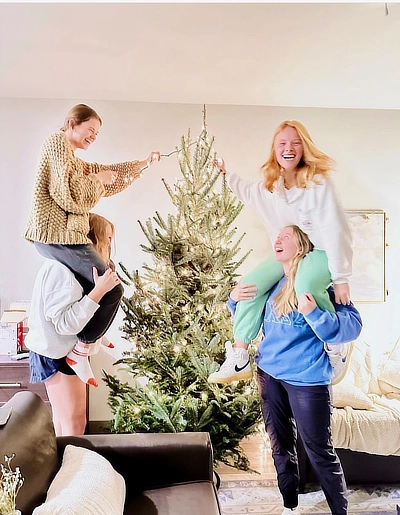Published on December 3, 2024 by Pam and Marc Hoppers

The holiday break is an exciting time for many of us with children in college. Once finals are submitted, we have our kids back in the home and they have a break. My hope for your Christmas break, from one Samford parent to another, is that it is a time for meaningful connection with your student.
Below are some tips as you navigate re-entry. After a few months away, you and your student are both bound to have picked up some new habits and quirks that may take some getting used to.
- Make space for spiritual connection. Use family worship services, shared meals and Advent observances as natural opportunities for meaningful conversations. Pray for wisdom in creating moments that deepen your relationship with your young adult.
- Navigate re-entry with patience. Students often return home with idealized memories and expectations of holidays past. They may also be processing changes in high school friendships while developing new college relationships. Give them space to adjust to these transitions.
- Balance support with independence. While it's tempting to pamper your returning student, excessive caretaking could hinder their growing independence. Consider whether your help empowers or impedes their development.
- Prioritize rest and recovery. After the intensity of final exams and end-of-semester activities, students need time to decompress and resettle into family rhythms. Support their mental and physical well-being by allowing adequate downtime.
- Respect their need for solitude. Many students, especially those adjusting to first-time roommates, benefit from quiet alone time. Avoid overscheduling their break.
- Set clear family expectations upfront. Discuss shared responsibilities like car use, household chores and maintaining common spaces before their arrival. This helps students, who've been focused on their individual needs, readjust to family life.
- Choose your conflicts wisely. Consider relaxing rules about things such as curfews, appearance and room organization. Remember that they've been managing their own schedule, look and living space at college.
- Ask thoughtful questions about their college experience. While it's natural to be curious, excessive questioning can overwhelm students, especially if they're struggling to adjust. Consider using Samford TALKS cards to facilitate natural family conversations.
- Create a safe space for evolving perspectives. As students continue to develop their worldview, they may challenge family beliefs and decisions. Foster open dialogue that allows them to express different viewpoints without fear of judgment.
- Embrace imperfect transitions. Remember that enthusiasm about returning to campus isn't a rejection of home – it's a sign of successful launching into adulthood.
- Plan intentional time with your student. Arrange one-on-one activities that cater to shared interests, whether it's cooking together, watching a favorite show or enjoying outdoor activities.
- Foster connections with siblings who may be adjusting to the family dynamic shift. Encourage shared activities that help maintain and strengthen these important relationships during the break.
- Create new traditions that bridge their college and home lives. Consider incorporating elements of their campus experience into family traditions, like making their favorite campus coffee shop drink at home or learning about their new interests.
- Document moments together thoughtfully. While it's natural to want photos and videos of family time, respect their boundaries about social media sharing and let them take the lead on what they're comfortable sharing.
Samford is a leading Christian university offering undergraduate programs grounded in the liberal arts with an array of nationally recognized graduate and professional schools. Founded in 1841, Samford is the 87th-oldest institution of higher learning in the United States. Samford enrolls 6,101 students from 45 states, Puerto Rico and 16 countries in its 10 academic schools: arts, arts and sciences, business, divinity, education, health professions, law, nursing, pharmacy and public health. Samford fields 17 athletic teams that compete in the tradition-rich Southern Conference and ranks with the second highest score in the nation for its 98% Graduation Success Rate among all NCAA Division I schools.
